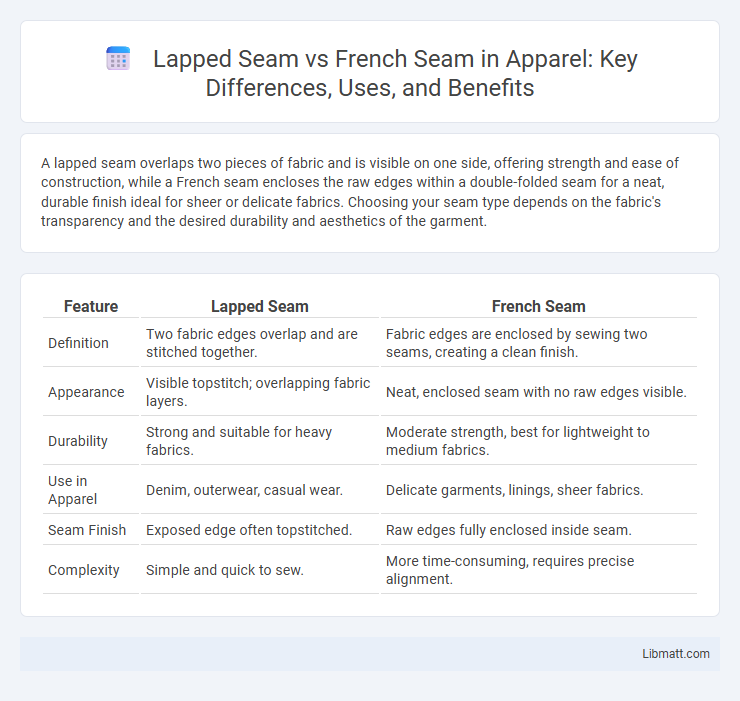A lapped seam overlaps two pieces of fabric and is visible on one side, offering strength and ease of construction, while a French seam encloses the raw edges within a double-folded seam for a neat, durable finish ideal for sheer or delicate fabrics. Choosing your seam type depends on the fabric's transparency and the desired durability and aesthetics of the garment.
Table of Comparison
| Feature | Lapped Seam | French Seam |
|---|---|---|
| Definition | Two fabric edges overlap and are stitched together. | Fabric edges are enclosed by sewing two seams, creating a clean finish. |
| Appearance | Visible topstitch; overlapping fabric layers. | Neat, enclosed seam with no raw edges visible. |
| Durability | Strong and suitable for heavy fabrics. | Moderate strength, best for lightweight to medium fabrics. |
| Use in Apparel | Denim, outerwear, casual wear. | Delicate garments, linings, sheer fabrics. |
| Seam Finish | Exposed edge often topstitched. | Raw edges fully enclosed inside seam. |
| Complexity | Simple and quick to sew. | More time-consuming, requires precise alignment. |
Introduction to Seam Finishes
Lapped seams and French seams are essential seam finishes that enhance garment durability and aesthetic appeal. Lapped seams create strong, overlapping layers ideal for heavy fabrics or waterproof garments, providing excellent resistance to fraying. French seams encase raw edges within a double stitch line, offering a clean, delicate finish perfect for lightweight or sheer fabrics, ensuring Your clothing looks polished inside and out.
What is a Lapped Seam?
A lapped seam is a type of seam where one fabric edge overlaps the other, creating a strong, flat join often used in outerwear and upholstery for durability and water resistance. This seam is stitched through both layers together, providing extra reinforcement compared to other seams. Its design helps prevent fabric fraying while maintaining a clean finish, making it suitable for heavy-duty applications.
What is a French Seam?
A French seam is a sewing technique that encases the raw edges of fabric within a double-stitched seam, providing a clean and durable finish ideal for lightweight or sheer fabrics. Unlike a lapped seam, which overlaps and stitches two fabric edges together, the French seam hides all raw edges, preventing fraying and ensuring a polished look on both sides of the garment. This method is commonly used in high-quality garment construction for a neat, professional inside appearance and enhanced seam strength.
Lapped Seam Construction Steps
Lapped seam construction involves overlapping two fabric edges, folding one edge under the other, then stitching them together to create a strong, durable joint commonly used in denim and outerwear. This method requires precise alignment of fabric edges, pressing the overlap flat, and using a straight or double row of stitches to ensure reinforcement and prevent fraying. The process provides a bulkier seam finish compared to the French seam, which encloses raw edges for a cleaner, delicate look ideal for lightweight or sheer fabrics.
French Seam Construction Steps
French seam construction involves sewing the fabric wrong sides together with a narrow seam allowance, trimming the seam allowance, then pressing and folding the fabric right sides together to encase the raw edges. A second seam is sewn close to the folded edge, creating a neat, durable, and fully enclosed seam ideal for delicate or sheer fabrics. This method enhances garment durability and provides a clean finish, preventing fraying and improving overall seam strength.
Fabric Suitability for Each Seam
Lapped seams work best with medium to heavy-weight fabrics like denim, canvas, and upholstery materials due to their durability and reinforced structure. French seams are ideal for lightweight and delicate fabrics such as silk, chiffon, and voile, providing a clean, enclosed finish that prevents fraying and enhances garment appearance. Your choice between these seams should consider fabric type to ensure optimal strength and aesthetic quality in the final product.
Durability: Lapped Seam vs French Seam
Lapped seams provide superior durability for heavy-duty or outdoor garments due to their overlapping fabric layers, which resist wear and water penetration. French seams, while offering a clean and refined finish ideal for lightweight or delicate fabrics, are less robust under high stress or frequent washing. Choosing between lapped and French seams depends on the garment's intended use and required longevity.
Appearance and Aesthetic Differences
Lapped seams create a flat, durable finish with visible stitching on the exterior, suited for casual or utilitarian garments, while French seams offer a clean, polished look with enclosed raw edges, ideal for delicate fabrics and high-end apparel. The French seam's double stitching enhances the garment's elegance by hiding all raw edges and providing a smooth, refined silhouette. In contrast, lapped seams emphasize structural strength over subtle aesthetics, making them less ideal for garments where a seamless, sophisticated appearance is preferred.
Common Uses and Applications
Lapped seams are commonly used in outdoor gear, tents, and waterproof garments due to their strength and water-resistant properties, making them ideal for heavy-duty and protective clothing. French seams are favored in delicate fabrics like silk and chiffon, often found in high-end fashion and lingerie, providing a clean, elegant, and durable finish by enclosing raw edges. Your choice depends on the fabric type and desired durability, with lapped seams offering robust protection and French seams enhancing garment aesthetics.
Choosing the Right Seam for Your Project
Choosing between a lapped seam and a French seam depends on fabric type and desired durability; lapped seams offer strong waterproof joins ideal for outdoor gear, while French seams provide a clean, delicate finish perfect for lightweight or sheer fabrics. Consider the garment's purpose--lapped seams are suitable for heavy-duty wear and water resistance, whereas French seams excel in high-end apparel requiring minimal fraying and a polished interior. Your project will benefit from selecting a seam that balances strength, appearance, and fabric compatibility to ensure optimal performance and aesthetic.
lapped seam vs french seam Infographic

 libmatt.com
libmatt.com